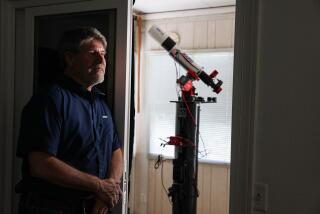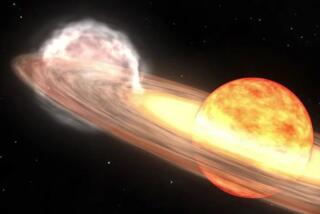Hubble Finds Biggest Star Yet
- Share via
Like some movie stars, the spectacular nuclear-powered furnaces of hydrogen and helium that light up the night sky tend to flame out with as much drama as when they appeared on the scene. Now, astronomers at UCLA say they may have discovered the biggest star of all--a massive object 10 million times brighter than the sun.
And it appears to be heading for an early, violent death, shedding its mass in violent eruptions that have already produced an enormous glowing gas cloud that surrounds the star like a halo.
“Massive stars are burning their candles at both ends,” said UCLA astronomer Mark Morris, a scientist on the team that discovered the star. “They are so luminous that they consume their fuel at an outrageous rate, burning out quickly.”
The star, known as the Pistol star, after the shape of its surrounding gas cloud, or nebula, is not visible from Earth. It sits close to the center of our galaxy, the Milky Way, and so is shrouded by 25,000 light-years of intervening interstellar dust. However, the UCLA team was able to see it with the Hubble Space Telescope’s newly installed infrared eyes.
Estimates of the star’s brightness are based on calculations not yet published in a scientific journal, said UCLA astronomer Don F. Figer, the team leader. “The point was getting the image out to the public,” he said.
The true brightness of the star depends on uncertain factors such as its distance from Earth, the amount of dust obscuring the view and whether it is in fact one enormous star rather than a few smaller stars clustered too close together to resolve.
Unlike the sun, which astronomers believe was born about 5 billion years ago, the Pistol star probably came into being only between 1 million and 3 million years ago, according to the UCLA team. Although the sun should take another 5 billion years to run out of nuclear steam, the Pistol star is expected to explode in a supernova in another 1 million to 3 million years.
At the time of its birth, Figer said, the star may have been 200 times as massive as the sun. “This star could have been the most massive known,” with an estimated radius reaching the equivalent of at least the distance from the Earth to the sun, he said.
Stars ignite or “turn on” when so much matter accumulates in one clump that the force of gravity pushing inward is enough to fuse atoms together, starting a nuclear fire. Massive stars burn hotter, brighter, and use up fuel more quickly than smaller stars. In the process, they throw off tons of matter in violent eruptions, producing glowing clouds of gases known as nebula.
The pistol-shaped nebula surrounding this newly found object was probably formed in explosions thousands of years ago, the astronomers said.
Some evidence of the Pistol star was first detected by South African and Japanese astronomers in the early 1990s, and Figer relied on data taken from several observatories to calculate its brightness. The Hubble image of the star surrounded by its giant nebula, he said, “adds evidence that the nebula was ejected by the star.”






